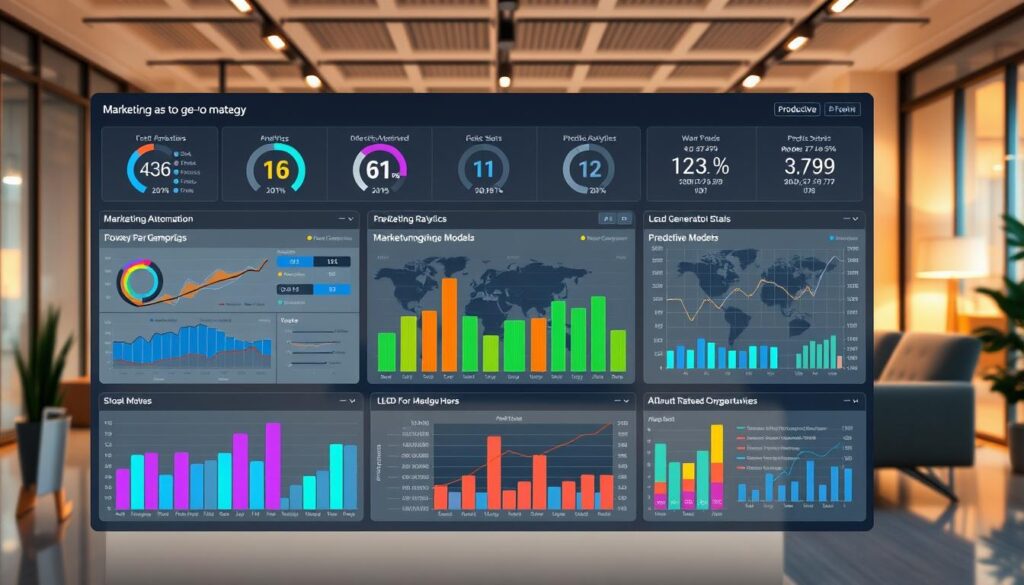In today’s fast-changing market, it’s key for businesses to use automation for their GTM strategies. This means using advanced automation to make operations smoother and improve service. Facing high customer expectations, it’s important to use technology that makes things efficient and simple. By automating routine tasks and using data as it comes, companies can fine-tune their marketing plans. This can lead to better experiences for customers. For those wanting to use these strategies well, looking into GTM optimization techniques is very helpful.
Key Takeaways
- Automation enhances the efficiency of GTM processes.
- Data-driven insights improve marketing approaches.
- Advanced solutions streamline workflow and communication.
- Customer experience is at the forefront of GTM strategies.
- Real-time data is crucial for optimizing decision-making.
- Investing in automation can drive sales growth effectively.
Introduction to GTM Process Optimization
The GTM (Go-to-Market) strategy is key for businesses launching new products. It shows how to connect with customers and make sure your product stands out. It involves market research, understanding your customers, positioning your product right, and preparing your sales team.
What is GTM (Go-to-Market) Strategy?
A strong GTM strategy acts like a map for companies to find and engage their customers. It focuses on getting to know the market, learning what customers want, and positioning the product to meet those needs. Companies like HubSpot and Salesforce are great examples. They’ve used GTM strategies to tackle market challenges and succeed.
Importance of Efficient GTM Processes
In today’s market, being efficient in your GTM process is crucial. Gartner says about 80% of businesses want to stand out through customer experience. This means they need to quickly adapt and meet customer needs with a smooth GTM approach, making them more flexible and ready for changes.
Role of Automation in GTM
Automation is key to making GTM efforts more efficient. It cuts down on manual work, keeping everything running smoothly. By using automation, businesses can work faster, be more precise, and use their teams better. This lets teams shift their focus to growth strategies for a stronger market position. To learn more about automation in GTM, check out this resource.
Benefits of Automating GTM Processes
Automating GTM processes offers big benefits for businesses. It boosts speed and efficiency for teams. This lets them focus on big picture tasks instead of routine ones. Automation also makes adopting best GTM practices easier, streamlining work and boosting performance.
Enhanced Speed and Efficiency
Automation gets rid of slow manual tasks in GTM. It speeds up routine tasks so teams finish projects quicker. This makes companies more productive and helps them launch campaigns and respond to market changes fast.
Improved Accuracy and Consistency
Automated GTM tools mean fewer mistakes. Less manual work leads to more accuracy, ensuring messages and campaigns are consistent. This quality boost improves customer experiences and keeps them coming back.
Cost Reduction and Resource Allocation
Automation helps cut costs by optimizing how resources are used. Teams can achieve more without spending more. This careful spending helps maximize returns and funds growth.
Key Areas for Automation in GTM
Automation is key in boosting Go-to-Market (GTM) strategies. It’s crucial in areas like lead management, running marketing campaigns, and managing customer relationships. By using advanced automation, these areas see better efficiency and results.
Lead Management and Scoring
Advanced automation helps sort and rank leads based on how they engage. This way, sales teams can focus on leads more likely to convert. Automation makes analyzing data in real-time easy, helping to tweak strategies quickly.
Marketing Campaign Execution
Successful marketing campaigns hit the right audience with precisely what they want to hear. GTM automation enables precise audience targeting and message tuning, using real-time data. This boosts engagement and makes marketing more effective.
Customer Relationship Management (CRM)
CRM is vital for keeping customers happy and loyal. Automation helps record every interaction and guarantees timely responses. This improves customer retention and offers a more tailored experience. Regular interactions through automation build stronger ties and ensure lasting success.
| Key Area | Benefits of Automation | Impact on GTM |
|---|---|---|
| Lead Management and Scoring | Efficient lead prioritization and higher conversion rates | Streamlined processes and optimized sales activities |
| Marketing Campaign Execution | Targeted messaging and increased audience engagement | Improved ROI on marketing investments |
| Customer Relationship Management | Systematic follow-ups and enhanced retention rates | Stronger customer relationships and loyalty |
Selecting the Right Tools for Automation
Finding the right automation tools is key for GTM plans to work well. Making a smart choice boosts tasks and helps manage operations better. To pick well, focus on various important aspects.
Criteria for Evaluating Automation Solutions
Here are important things to think about when looking at automation options:
- Ease of Use: A simple interface makes it easier to get started and cuts training time.
- Integration Capability: The tools should work well with what you already have for smooth data flow.
- Scalability: They need to grow with your business without losing quality.
- Support: Good customer service makes things easier, especially at first.
- Cost-Effectiveness: It’s wise to compare prices and what you get to make a smart investment.
Popular Automation Tools for GTM
Check out these top automation tools for GTM plans:
| Tool Name | Key Features | Industry Focus |
|---|---|---|
| HubSpot | Marketing automation, CRM, analytics | Marketing & Sales |
| Salesforce | CRM, lead management, analytics | Sales & Customer Support |
| Demandbase | Account-based marketing, targeting, analytics | B2B Marketing |
Integration with Existing Systems
Linking automation tools with what you already use is vital. It makes operations run smoothly and gives useful insights. This setup helps teams stay efficient without changing how they work too much.

Implementing Automation: Best Practices
Setting up effective automation for your GTM involves thought-out planning and careful action. A well-planned strategy makes sure operations run smoothly and aligns automation with the company’s goals. By sticking to the best practices in GTM automation, businesses can make their GTM processes better and more efficient.
Developing a Clear Automation Strategy
Creating a clear plan for automation is key to doing it right. This plan needs to set specific goals and expected results. That way, everyone knows where they’re headed and why. Writing down how things should work and what everyone’s role is makes it easier for teams to work together towards a common goal.
Training and Supporting Your Team
As you start using more automated methods, training your team is very important. Making sure your team knows how to use the new tools gives them confidence. Giving them ongoing help and more training when needed makes them more capable. This ensures they can smoothly transition to using automation in your GTM approach.
Monitoring and Adjusting Automation Efforts
It’s important to keep an eye on how the automated systems are doing. Checking on things regularly lets you see what works and what doesn’t. Being ready to change things based on what you learn makes automation even more effective. This way, automation keeps getting better at boosting your GTM activities.
| Best Practice | Description | Expected Outcome |
|---|---|---|
| Clear Strategy Development | Define objectives and outcomes | Improved focus and alignment |
| Team Training | Provide resources and support | Increased efficiency and confidence |
| Continuous Monitoring | Track performance and adjust | Enhanced effectiveness of automation |
Measuring the Impact of Automation on GTM
It’s vital for businesses to know how automation affects their Go-To-Market (GTM) strategies. They should focus on key indicators that show if their efforts are working. This way, they can see what’s working well and what needs work.
Key Performance Indicators (KPIs) to Track
For measuring automation’s impact on GTM, it’s important to track the right KPIs. Key KPIs include:
- Lead conversion rates
- Customer engagement levels
- Campaign performance metrics
- Time to market for new products
- Customer acquisition cost
Analyzing Success and Areas for Improvement
Once you know which KPIs to watch, you need to study them carefully. Regularly checking these metrics helps a lot. Use a structured method, like the table below, to understand the data better:
| Performance Metric | Before Automation | After Automation | Change (%) |
|---|---|---|---|
| Lead Conversion Rate | 20% | 35% | +75% |
| Customer Engagement Level | 60% | 80% | +33% |
| Campaign Performance | $10,000 | $7,500 | -25% |
This analysis proves how vital it is to measure automation’s impact on GTM. Making changes based on this data can improve strategies. By always checking the impact, businesses can stay ahead. They’ll be ready to adapt to new market trends and customer needs.

Future Trends in GTM Automation
The future brings exciting changes with AI and machine learning changing how we do business. These technologies mean we can make marketing much more personal and decisions smarter with analytical insights. Companies will be able to meet customer needs better and adjust strategies instantly.
AI and Machine Learning in GTM
AI and machine learning are shaking things up in how we talk to customers. Companies can now find specific groups of customers, customize messages, and even guess what customers will do next. This lets GTM teams give content that hits the mark, leading to more sales. Future trends in GTM automation show that these tech tools let teams send many messages that still feel personal, keeping them ahead in the game.
The Rise of Predictive Analytics
Predictive analytics is changing everything for GTM plans. By looking at past data, companies can see what’s coming and get ready for changes. This means they can sell smarter and use resources better. Companies focused on these new trends will lead, making choices that match quickly changing customer needs.
Preparing for Changing Market Dynamics
To win in changing markets, companies must be ready to adapt. This means using advanced GTM tech that helps understand data and get quick feedback. Companies should always improve their automated strategies to make sure they serve customers well and stay ahead. Being up-to-date with GTM trends helps companies grow and succeed in today’s fast-moving world.
FAQ
What is the key benefit of optimizing GTM processes with automation?
The main advantage is better speed and performance. By using automation for routine tasks, teams can focus on strategic work. This boosts the overall success of GTM activities.
How does automation improve the accuracy of GTM processes?
Automation cuts down on mistakes by making processes consistent. This leads to more accurate campaigns and interactions with customers. It makes marketing efforts more effective.
Which areas should companies prioritize for GTM automation?
Companies should automate lead management and scoring, campaign execution, and CRM. This ensures good organization, execution, and follow-up.
What criteria should be considered when selecting automation tools for GTM?
Consider ease of use, how well tools work with current systems, growth support, customer support, and cost. HubSpot, Salesforce, and Demandbase are great options.
What are some best practices for implementing automation in GTM?
Start with a clear plan for automation. Make sure your team is well-trained. Always check and tweak your automation to spot issues and gauge success.
How can organizations measure the success of their GTM automation efforts?
Look at key measures like lead conversion rates, campaign results, and how much customers engage. These indicators help judge how well automation is working.
What future trends should businesses be aware of regarding GTM automation?
Future trends are about bringing AI and machine learning into GTM. They will improve customization and choices by using predictive analysis.



